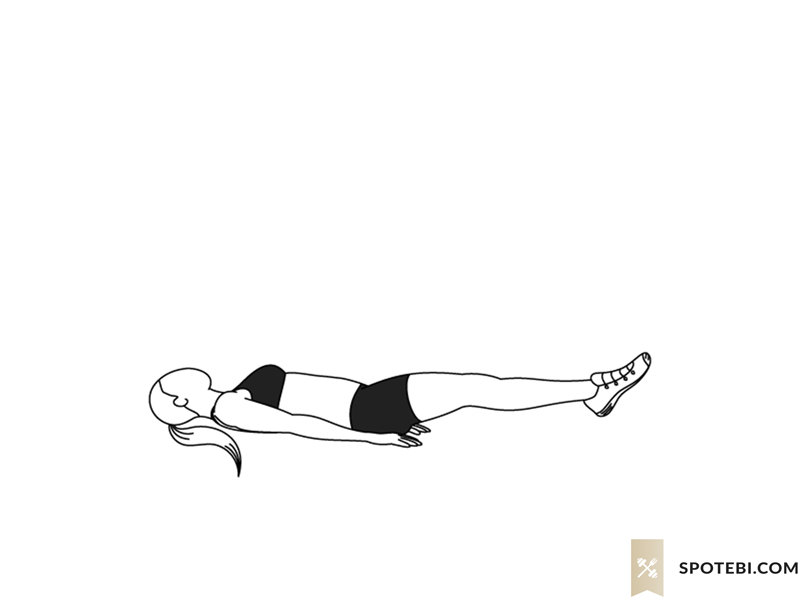What are leg raises?
The leg raise is a bodyweight exercise that targets the lower abdominal muscles in the core. It can be performed from a lying position on the floor, on a bench, on a dedicated station or from a hanging position. Sit-ups and crunches tend to target the upper abdominal muscles so if you want a full and developed six-pack, add leg lifts into your ab routine.
Which muscles are worked with leg raises?
Leg raises target the abdominal muscles and to a lesser extent, the quad muscles in the upper legs and the oblique muscles alongside the abdominals.
Although leg raises activate the entire abdominal region, more emphasis is placed on the lower abdominals which can often be overlooked with other abdominal exercises.
If you want to hit the entire abdominal region, make sure that your routine includes a regular ab circuit consisting of crunches, leg raises and ab rollouts. By adding twists into any of these movements, you can engage the obliques to a higher extent.
How do I perform leg raises?
There are a few different ways of performing leg raises. The apparatus you use will hit the abdominals from a different angle and load the muscle at different points of the movement.
Gravity is providing the resistance with leg raises so, by performing a lying leg raise, the majority of the strain will come at the beginning of the movement and, as your legs come over the top of your body, the resistance is diminished.
With a hanging leg raise (or leg raise station), there is little resistance at the beginning of the movement but more so at the top. This makes a good case for using a mixture of leg raise positions in your routine to make sure that all of the abdominal fibres in the lower abdominals are being broken down.
The lying leg raise.
The lying leg raises are the easiest of the leg raise exercises to perform making them popular with beginners. It can be performed on the floor, on an abdominal bench or just on a simple dumbbell bench.

For this example, we will be looking at the lying leg raises on the floor.
- Place a mat on the floor, lie on your back on the mat with a straight spine and your palms facing downwards for stability.
- Take a deep breath, upon exhale, raise your legs to a right angle. Legs can be slightly bent but must remain rigid.
- Hold the top of the movement for a second or two before slowly lowering your legs down again.
- Focus on an explosive upwards movement with a slow, controlled downwards motion. Make sure that you can feel the connection with your abdominals.
- Before your feet touch the ground, lift the legs again for another rep. Don't let your feet rest on the ground until you have completed the set to keep tension on the abdominals.
- Repeat for the required number of reps and sets.
Make sure that you are breathing in on the negative motion and out on the positive motion. Keep your breathing constant throughout the exercise.
This exercise can be performed on a flat bench or an incline bench in exactly the same motion. Instead of placing your palms on the bench for stability, reach behind your head and grab the handle or edge of the bench to really isolate the core.
Hanging leg raise.
Hanging leg raises can be performed on gymnastic rings, a pull-up bar or on a dedicated dip/leg raise station. The movement is exactly the same with either method.
With the rings or pull-up bar, you will literally be hanging from them so you need to have a good grip strength a dip station is easier as you can rest your forearms on the pads and let them take the strain.
- Grab the bar with an overhand grip and hang from it with a grip slightly wider than shoulder-width.
- Keep your feet together. Legs can be slightly bent but must be rigid.
- Take a deep breath, upon exhale, lift the legs to a right angle and hold for a second or two.
- Slowly lower the legs to the starting position.
- Before they get a chance to relax, repeat the movement immediately so that the abdominals stay under constant tension.
- Repeat for the desired number of reps and sets.
- Make sure that you are not swinging too much with the movement and that you can feel a connection with the target muscles.
- You can add a twist to the movement to engage the obliques.
As with lying leg raises, focus on breathing, a controlled motion and muscle connection. If you find the movement too easy, slow the negative motion right down to 5-6 seconds or grip a dumbbell between your feet.
If you are new to leg raises and find them too hard, you can start by just raising the knees by bending the legs. This will not put give as much resistance to the abdominals but will still activate them and get them used to the motion.



